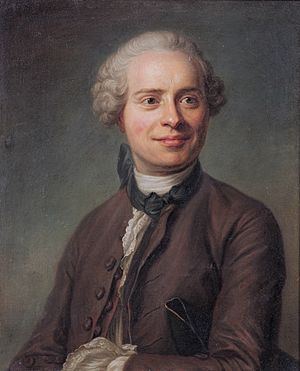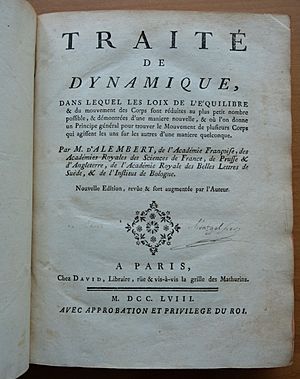Jean le Rond d'Alembert facts for kids
Quick facts for kids
Jean le Rond d'Alembert
|
|
|---|---|

Pastel portrait of d'Alembert by Maurice Quentin de La Tour, 1753
|
|
| Born |
Jean-Baptiste le Rond d'Alembert
16 November 1717 Paris, France
|
| Died | 29 October 1783 (aged 65) Paris, France
|
| Nationality | French |
| Alma mater | University of Paris |
| Known for | D'Alembert criterion D'Alembert force D'Alembert's form of the principle of virtual work D'Alembert's formula D'Alembert's equation D'Alembert operator D'Alembert's paradox D'Alembert's principle D'Alembert system D'Alembert–Euler condition Tree of Diderot and d'Alembert Cauchy–Riemann equations Fluid mechanics Encyclopédie Three-body problem |
| Awards | Fellow of the Royal Society Fellow of the Institut de France |
| Scientific career | |
| Fields | Mathematics Mechanics Physics Philosophy |
| Notable students | Pierre-Simon Laplace |
Jean-Baptiste le Rond d'Alembert (born November 16, 1717 – died October 29, 1783) was a very smart French thinker. He was a mathematician, a physicist, a philosopher, and even a music expert. He helped create one of the first big encyclopedias, the Encyclopédie. Many important ideas in math and physics are named after him.
Contents
Early Life and Education
Jean d'Alembert was born in Paris, France. His mother left him on the steps of a church when he was just a baby. He was named after the church's saint, Saint-Jean-le-Rond.
His father, an army officer, found him and arranged for him to live with a kind glazier's wife, Madame Rousseau. Jean lived with her for almost 50 years. His father secretly paid for his education.
When he was 12, d'Alembert went to a school called Collège des Quatre-Nations. There, he studied philosophy, law, and arts. He earned his degree in 1735. He later studied law and became a lawyer in 1738. He was also very interested in medicine and mathematics.
A Brilliant Career
In 1739, d'Alembert made his first important math discovery. He found mistakes in a well-known math book. This showed how talented he was.
He also studied how liquids and gases move, which is called fluid dynamics. In 1740, he explained how light bends when it goes through solid objects.
Because of his amazing work, d'Alembert was chosen to join the French Academy of Sciences in 1741. He also became a member of other important science groups, like the Berlin Academy and the Royal Society.
In 1743, he published his most famous book, Traité de dynamique (Treatise on Dynamics). In this book, he shared his own important rules about how things move. These rules are now known as D'Alembert's principle.
The Encyclopédie
One of d'Alembert's biggest projects was the Encyclopédie. This was a huge book series that aimed to gather all human knowledge. He worked as a co-editor with Denis Diderot, focusing on math and science. He wrote over a thousand articles for it! He also wrote the famous Preliminary Discourse, which was like an introduction to the whole encyclopedia.
In 1752, he wrote about something called D'Alembert's paradox. This idea suggests that an object moving through a perfect, smooth liquid or gas would have no drag (resistance).
D'Alembert was elected as the Permanent Secretary of the French Academy of Sciences in 1772.
Music and Personal Life
D'Alembert was also very interested in music theory. He studied the ideas of another famous French musician, Jean-Philippe Rameau. D'Alembert wrote a book called Elements of Music to explain Rameau's theories. He believed music was a mathematical science.
D'Alembert enjoyed spending time in Parisian salons, which were like social gatherings for smart people. He became very close with a woman named Julie de Lespinasse and lived with her.
Later Years and Legacy
D'Alembert had poor health for many years. He passed away in Paris in 1783. He was buried in a common, unmarked grave.
Many of his ideas are still important today:
- The fundamental theorem of algebra is sometimes called the d'Alembert/Gauss theorem.
- He created the ratio test, a way to check if a math series adds up to a certain number.
- The D'Alembert operator is a key idea in modern physics.
He also had an interesting idea about gambling. He incorrectly thought that if a coin landed on tails many times, it was more likely to land on heads next. This led to a gambling strategy called the D'Alembert system.
A small island in South Australia, Lipson Island, was once named Ile d'Alembert by a French explorer.
Fictional Stories About Him
D'Alembert has appeared in books. For example, the novel D'Alembert's Principle by Andrew Crumey is named after his physics idea. It tells parts of his life story.
List of Works
- D'Alembert, Jean Le Rond (1743). Traité de dynamique (2nd ed.). Gabay (1990 reprint). http://gallica.bnf.fr//ark:/12148/bpt6k29043t.
- D'Alembert, Jean Le Rond (1747a). "Recherches sur la courbe que forme une corde tenduë mise en vibration (Researches on the curve that a tense cord forms [when set into vibration)"]. Histoire de l'académie royale des sciences et belles lettres de Berlin. 3. pp. 214–219. https://books.google.com/books?id=lJQDAAAAMAAJ&pg=PA214.
- D'Alembert, Jean Le Rond (1747b). "Suite des recherches sur la courbe que forme une corde tenduë mise en vibration (Further researches on the curve that a tense cord forms [when set into vibration)"]. Histoire de l'académie royale des sciences et belles lettres de Berlin. 3. pp. 220–249. https://books.google.com/books?id=lJQDAAAAMAAJ&pg=PA220.
- D'Alembert, Jean Le Rond (1750). "Addition au mémoire sur la courbe que forme une corde tenduë mise en vibration". Histoire de l'académie royale des sciences et belles lettres de Berlin. 6. pp. 355–60. https://books.google.com/books?id=m5UDAAAAMAAJ&pg=PA355.
- (in fr) Recherches sur differens points importans du systeme du monde. 1. Paris: Michel Antoine David. 1754. https://gutenberg.beic.it/webclient/DeliveryManager?pid=12210742.
- (in fr) Recherches sur differens points importans du systeme du monde. 2. Paris: Michel Antoine David. 1754. https://gutenberg.beic.it/webclient/DeliveryManager?pid=12211771.
- (in fr) Recherches sur differens points importans du systeme du monde. 3. Paris: Michel Antoine David. 1756. https://gutenberg.beic.it/webclient/DeliveryManager?pid=12212716.
- D'Alembert, Jean Le Rond (1995). Preliminary Discourse to the Encyclopedia of Diderot. University of Chicago Press.
- (in fr) Traité de dynamique. Paris: Jean-Baptiste Coignard (3.). 1743. https://gutenberg.beic.it/webclient/DeliveryManager?pid=15685.
- Mémoire sur le calcul intégral (1739), prima opera pubblicata
- Traité de l'équilibre et du mouvement des fluides (1744)
- Réflexions sur la cause générale des vents (1746)
- Recherches sur les cordes vibrantes (1747)
- Recherches sur la précession des equinoxes, et sur la mutation de l'axe de la terre, dans le systême newtonien. A Paris: Jean Baptiste Coignard. 1749. https://gutenberg.beic.it/webclient/DeliveryManager?pid=161494.
- Éléments de musique, théorique et pratique. Lyon: Jombert, Charles Antoine; Bruyset, Jean-Marie (1.). 1759. https://gutenberg.beic.it/webclient/DeliveryManager?pid=1265357.
- Essai d'une nouvelle théorie de la résistance des fluides (1752)
- Essai sur les éléments de philosophie (1759)
- (in fr) Nouvelles expériences sur la résistance des fluides. Paris: Jean François Louis Chardon. 1777. https://gutenberg.beic.it/webclient/DeliveryManager?pid=14723.
- Éloges lus dans les séances publiques de l'Académie française (1779)
- Opuscules mathématiques (8 tomi 1761-1780)
- Œuvres complètes, Éditions CNRS, 2002. ISBN: 2-271-06013-3
- Encyclopédie ou dictionnaire raisonné des sciences, des arts et des métiers, Flammarion, 1993. ISBN: 2-08-070426-5
- Nouvelles expériences sur la résistance des fluides, par mm. D'Alembert ... & l'Abbé Bossut .... A Paris: rue Dauphine, chez Claude-Antoine Jombert, fils ainé, libraire du Roi pour le Génie & l'Artillerie. 1777. https://gutenberg.beic.it/webclient/DeliveryManager?pid=14723.
- (in en) Mélanges de littérature, de philosophie et d'histoire. London: printed for C. Henderson : and sold by T. Becket and P. A. De Hondt, in the Strand. 1764. https://gutenberg.beic.it/webclient/DeliveryManager?pid=7847641&custom_att_2=simple_viewer&search_terms=DTL5&pds_handle=.
- (in fr) [Opere]. 1. Paris: A. Belin. 1821. https://gutenberg.beic.it/webclient/DeliveryManager?pid=12418840.
- (in fr) [Opere]. 2. Paris: A. Belin. 1821. https://gutenberg.beic.it/webclient/DeliveryManager?pid=12420721.
- (in fr) [Opere]. 3. Paris: A. Belin. 1821. https://gutenberg.beic.it/webclient/DeliveryManager?pid=12422650.
- (in fr) [Opere]. 4. Paris: A. Belin. 1822. https://gutenberg.beic.it/webclient/DeliveryManager?pid=12424945.
- (in fr) [Opere]. 5. Paris: A. Belin. 1822. https://gutenberg.beic.it/webclient/DeliveryManager?pid=12426640.
- (in fr) Oeuvres et correspondances inedites. Paris: Librairie Académique Didier. 1887. https://gutenberg.beic.it/webclient/DeliveryManager?pid=11824502.
Images for kids
See also
 In Spanish: Jean le Rond d'Alembert para niños
In Spanish: Jean le Rond d'Alembert para niños
- List of liberal theorists
- List of things named after Jean d'Alembert




